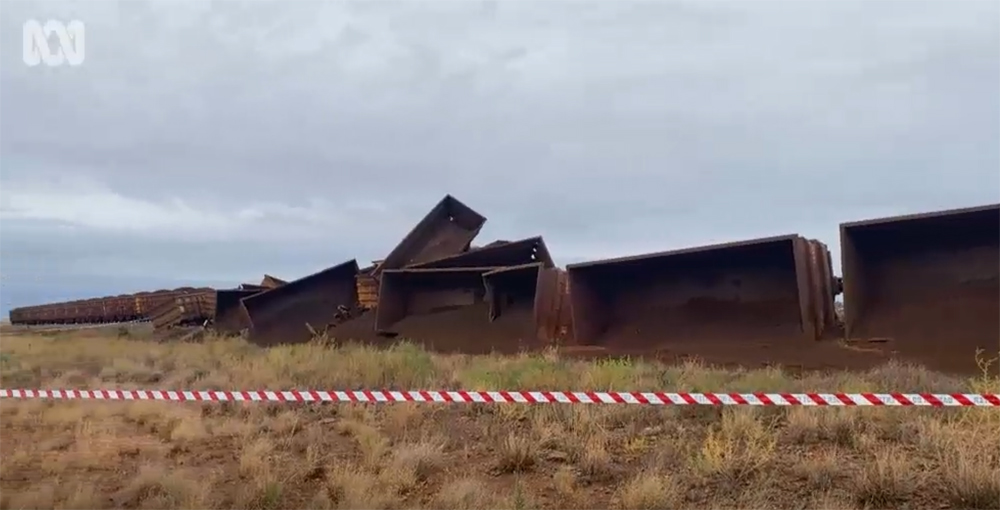
KARRATHA, Australia — Australian mining giant Rio Tinto has begun an investigation after 30 cars of one of its autonomous iron ore trains derailed Saturday.
National broadcaster Australian Broadcasting Corp. reports the Office of the National Rail Safety Regulator had been notified. The ONRSR told the Australian Associated Press that initial indications were that onboard safety systems worked properly, but “the incident will be the subject of further regulatory activities.”
A Rio Tinto representative told ABC that the loaded train was headed to the Port of Dampier when the derailment occurred. No one was injured.
Rio Tinto began operating the autonomous trains — with two to three locomotives and 240 cars carrying about 28,000 metric tons of iron ore — in 2019. The trains travel from 16 mines to Dampier or Cape Lambert, averaging 40 hours for a 500-mile trip.
Karratha, in Western Australia’s remote Pilbara region, is adjacent to the Port of Dampier. Perth, the nearest major city, is a 16-hour drive to the south.














Having checked the video, the vehicles involved were the trailing vehicles on the train. I can only count 30 vehicles in the photo, including those still on the track at the rear, although there may be others not visible. Assuming there were 200 vehicles plus three locomotives on the train, it would appear that around three quarters of the train was unaffected, and had been moved to the Seven Mile Yard to await dumping by the time the News cameras arrived. The railway fences are some distance from the line at this location, so there isn’t much chance of an innocent bystander being affected. I have seen many relatively minor derailments like this during the years I worked in the Pilbara and while the iron ore is a problem to remove, there being 140 tonnes (150 US tons) or so in each car, the cars themselves are fairly light and compact. My recollection is that manned trains were allowed 50mph empty and 40mph loaded (in order to reduce track impacts forces from the heavily loaded wagons. I think the section involved is double track, so traffic was probably resumed as soon as the unaffected track was clear.
The train has ECP braking, which would have increased the speed of brake application and more importantly allowed simultaneous braking on all vehicles. The trains are monitored throughout their journey, so the derailment would have been obvious from the uncommanded brake application within seconds of the derailment occurring. It is unlikely to have been a pre-existing track defect that caused the derailment since most of the train was unaffected. A bearing failure seems most likely. Rio Tinto uses standard hot bearing detectors and has “dragging equipment detectors”, cast iron bars between and beside the rails to break if hit by anything on a train in the wrong place. A wheel could have cracked and moved on the axle, but a bearing failure would seem most likely.
But there is nothing to suggest that a crewed train would have reacted differently, particularly as the failure appears to have been around 150 cars behind the locomotives.
Peter
There has been an automated/unmanned train system running at Labrador City iron ore mine for decades if it’s still in operation. I saw it in August 1989 while getting the QNS&L to both Schefferville and Labrador City. Unmanned ore trains set to blast their horns every 15 seconds. Anyone know about their operational record regarding derailments?
No one was injured……..
Not so obvious. There could have been someone on the ground.
Even “autonomous ore trains” with the best technology can derail. Was it a broken rail, broken wheel bearing or hot box (how are they handled in Australia?), gauge spreading or debris on the track? How long did it take for Rio Tinto’s Ops Center to notice the derailment? Is their anything the US rail industry can learn from this?
Even these trains travel loaded at a very slow pace. 500 miles in 40 hours is a snails pace. (12.5 mph) Maybe slowing down is the smart thing to do with long trains. Somehow I can’t see American Class 1’s crawling along like that, although they might be granted their one man crew status if that was the max speed limit.
You have to remember that 40 hour travel time also includes the time it takes to load at the various mines and the time to unload at the Port. So actual line haul speed is higher that 12.5 mph, I recall from the two articles in Trains on those lines that the trains move along at up to 40 mph.
As the other responder pointed out, that time does include the loading and unloading time. Track speed isn’t any slower than it was when they were crewed, when the full cycle was closer to 43 hours.